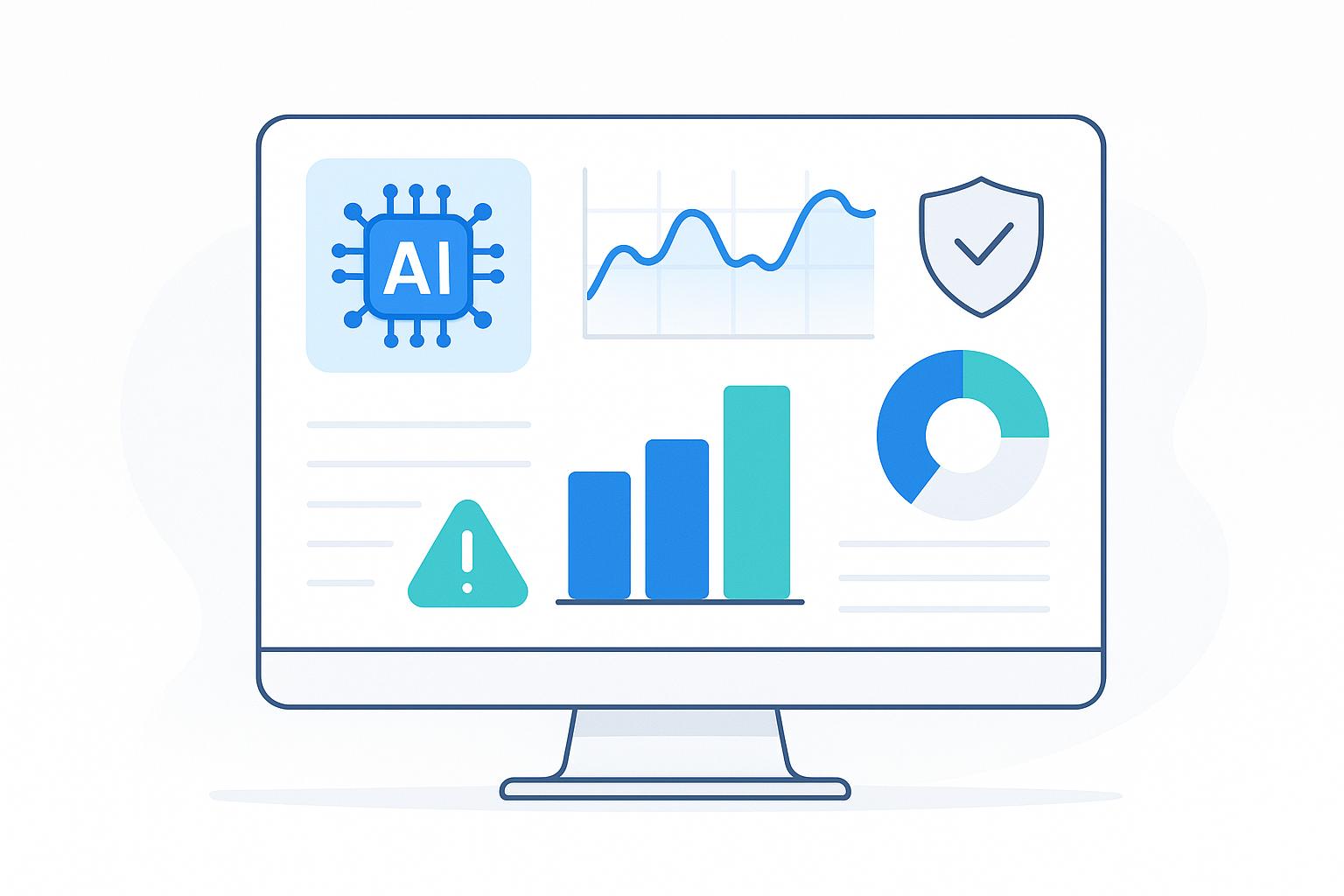Real-time board reporting helps businesses make faster decisions with up-to-date data. It replaces outdated monthly or quarterly reports and provides instant insights into financial performance and metrics. Here's what you need to know:
- Why It Matters: Access to live data minimizes decision delays, improves accuracy, and enhances resource allocation.
- Key Metrics to Track: Cash flow, growth metrics (MRR/ARR), operational KPIs, and ROI.
- Tools You Need: Financial platforms, data connectors, security tools, and visualization dashboards.
- Benefits: Faster decisions, better investor communication, and proactive financial management.
- Steps to Get Started:
- Integrate core financial systems like QuickBooks or payroll tools.
- Build dashboards tailored for board members.
- Train your team and use AI to automate insights.
Real-time reporting transforms how boards operate by enabling proactive, data-driven decisions. The article explains how to set up systems, maintain data quality, and create effective dashboards.
How to Create a Dashboard that Analyzes Data in Real-Time
Real-Time Financial Data Basics
Real-time financial data forms the backbone of dynamic board reporting, giving leaders instant insights to make informed decisions. Understanding its essential components helps create smarter and more efficient reporting systems.
Metrics Every Board Should Monitor
For effective decision-making, board members need quick access to key financial metrics. These metrics are often grouped into specific categories:
| Metric Category | Key Indicators | Update Frequency |
|---|---|---|
| Cash Management | Burn Rate, Runway, Cash Flow | Daily |
| Growth Metrics | MRR/ARR, Customer Acquisition Cost | Weekly |
| Operational KPIs | Gross Margin, Operating Expenses | Weekly |
| Investment Metrics | ROI, Unit Economics | Monthly |
Once these indicators are identified, the focus shifts to ensuring efficient data collection and integration.
"Lucid has made it incredibly easy to track spending, plan ahead, and handle our growth. It's straightforward and effective. Managing my finances has become much easier with this platform. It's user-friendly and efficient, saving me a lot of time and effort." - Aviv Farhi, Founder and CEO @Showcase
Connecting and Managing Data Sources
To enable real-time reporting, it's crucial to integrate data seamlessly from multiple financial sources:
-
Primary Financial Systems
Modern tools connect directly with accounting software, payroll systems, and banks. This eliminates manual data entry, reducing errors and improving accuracy. -
Ensuring Data Quality
Automated reconciliation, validation checks, and error detection systems maintain high data quality. -
Integration Architecture
Advanced setups leverage AI-driven integration, allowing boards to instantly compare scenarios, access industry benchmarks, create detailed financial plans, and provide real-time updates to investors.
Setting Up Real-Time Board Reports
Required Tools and Systems
Creating real-time board reports requires reliable technology. Here's a breakdown of the key components:
| Component Type | Purpose | Key Requirements |
|---|---|---|
| Financial Platform | Central hub for reporting | AI-based analytics and integration with various data sources |
| Data Connectors | Automates data collection | API support and real-time updates |
| Security Tools | Protects sensitive data | Strong encryption and access control |
| Visualization Tools | Creates clear presentations | Interactive dashboards with flexible customization |
Platforms like Lucid Financials offer integrations with QuickBooks, payroll systems, and banking tools. This eliminates manual work and ensures data stays up-to-date.
Once the tools are in place, the focus should shift to maintaining data quality and ensuring security.
Data Quality and Protection
Keeping data accurate and secure is crucial. Here’s how to do it:
-
Data Validation Protocols
Financial data should go through several validation steps before it appears in board reports. Automated reconciliation with original systems and tools for spotting anomalies can help catch errors or unusual trends. -
Security Framework
Use role-based access controls (RBAC) to ensure board members only see what’s relevant to them. Protect data with encryption during transfer and storage, and conduct regular security audits to stay compliant with industry standards. -
Backup and Recovery
Automate data backups with point-in-time recovery options to ensure you can restore data if needed.
Additional tips for maintaining data quality and security:
- Automate regular data quality checks and keep audit trails for transparency.
- Use version control for financial models and reports to track changes.
- Set up alerts for any unusual data patterns.
- Develop clear policies for data governance to avoid confusion or errors.
sbb-itb-17e8ec9
Creating Board Dashboards
Data Display Guidelines
Board dashboards should clearly and efficiently present financial data. Here's how to structure your real-time reporting dashboards for maximum clarity:
Visual Hierarchy
- Position important KPIs at the top for quick access.
- Group related metrics into sections with clear visual breaks.
- Use consistent color schemes to differentiate data categories.
For presenting financial data, these chart types work best:
| Chart Type | Best Used For | Key Tips |
|---|---|---|
| Line Charts | Showing trends and forecasts | Limit to 3-4 lines per chart |
| Bar Charts | Comparing revenue and budget | Stick to consistent colors |
| Gauge Charts | Tracking KPI progress | Add clear target markers |
| Waterfall Charts | Breaking down cash flow or P&L | Highlight start and endpoints |
Data Refresh Indicators
Show the last update timestamp clearly so board members know data is current. Add status indicators to confirm system integrations are functioning properly.
These visual strategies can be adjusted to suit the specific needs of your board members.
Board Member-Specific Views
Dashboards should be tailored to the roles of individual board members for maximum impact:
Executive View
- Focus on high-level KPIs and strategic metrics.
- Include company-wide performance data and year-over-year comparisons.
Finance Committee View
- Provide detailed cash flow analysis, burn rate tracking, and runway calculations.
- Highlight metrics like debt covenant compliance.
Operational Board Members
- Show department-specific metrics and resource allocation.
- Include efficiency indicators and project-based ROI.
To keep dashboards effective and relevant:
1. Regular Feedback Loops
Hold quarterly reviews with board members to gather input on their changing needs. Use this feedback to refine dashboard content and structure.
2. Dynamic Filtering
Allow users to filter data by time period, department, or project for deeper insights.
3. Contextual Notes
Add annotations to explain significant variances or key events for quick comprehension.
With tools like Lucid Financials' AI-powered insights, you can automatically identify important trends and anomalies. The platform's customizable views ensure each board member gets the exact information they need, right when they need it.
Making Real-Time Reports Work
Team Training and Adoption
Getting your team on board with real-time reporting starts with proper training. Here’s how you can make it work:
- Clear Documentation and Guidelines: Create detailed guides that cover everything from entering data to generating reports, performing quality checks, and accessing the system. These step-by-step instructions will help your team navigate the process confidently.
- Phased Implementation: Roll out real-time reporting features gradually. Start with basic metrics so the team can get comfortable before tackling more complex reporting tools.
A well-prepared team sets the stage for smoother operations and ongoing improvements.
Regular Updates and Improvements
Once the system is in place, it’s important to keep refining it. Regular updates, based on user feedback, ensure the reporting process stays efficient and aligned with your goals. Set up a feedback loop that involves board members, finance teams, department heads, and system analytics. This input helps identify what’s working and what needs adjustment, keeping the system relevant and effective.
AI-Powered Insights
After solid training and consistent updates, AI can take your reporting to the next level. Real-time reporting powered by AI provides deeper insights and automates complex tasks. Here’s how it can elevate your board reporting:
-
Automated Scenario Analysis:
- Quickly generate financial plans for best-case, worst-case, and actual scenarios.
- Compare multiple growth options.
- Adjust forecasts instantly based on real-time performance.
-
Intelligent Benchmarking:
- Access industry-specific performance data.
- Compare your company with peers.
- Analyze trends within your sector.
"We found a powerful yet simple solution for our financial planning needs, which has been a great addition to our business."
– Refael Shamir, Founder and CEO @Letos
Lucid Financials' AI tools handle tasks like variance analysis, cash flow forecasting, risk assessment, and dynamic KPI tracking. These capabilities allow boards to make quicker, better-informed decisions while keeping a clear view of company performance.
Next Steps
Key Benefits
Real-time board reporting helps businesses make faster financial decisions and stay well-informed. For startups and small businesses, adopting this system offers benefits like:
- Faster decisions driven by up-to-date data
- Better use of resources with scenario planning
- Easier communication and updates for stakeholders
How to Get Started
To make the most of these benefits, follow these steps to bring real-time reporting into your workflow:
- Connect core data sources like QuickBooks, payroll systems, and banks to enable live financial tracking.
- Set up tailored dashboards to display key metrics that matter most to your board members.
- Train your finance team and stakeholders to ensure everyone uses the system effectively.
Lucid Financials simplifies this process with AI-driven setup tools and ready-to-use templates suited for different business needs. Its automation features make transitioning to real-time reporting smooth while keeping your data accurate and secure.


